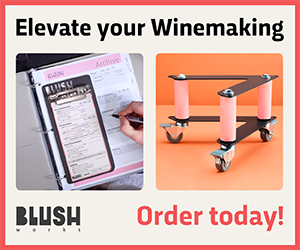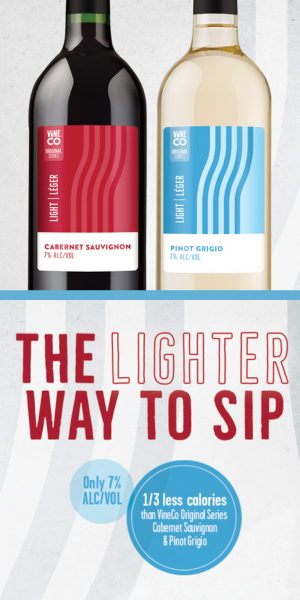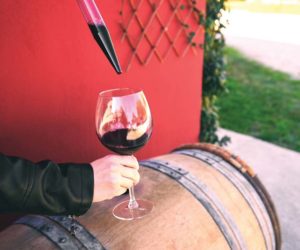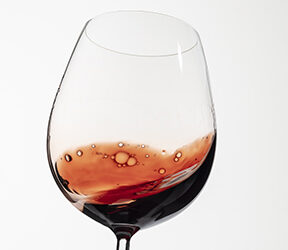Q
I’ve just started making wine at home and I’m not committed enough to the hobby to drop $1,500 USD (or more!) on a French or American oak barrel, let alone make 59 gallons (225 L) (that’s almost 25 cases) of wine. I want to make a good red, maybe this year with a kit and maybe with grapes if I can find some — what are the ways I can make a smaller batch yet still get some oak aromas and flavors into my finished product without breaking the bank? And how do I use them?
Lettie Contreras
Atascadero, California
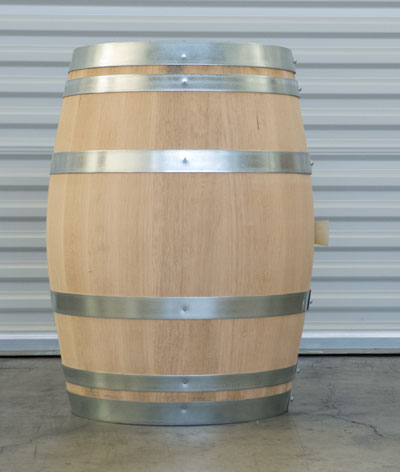
I hear you about not wanting to drop that kind of cash for a new barrel, especially as a new hobbyist. If you spread the cost of “good use” years for a new barrel over the volume of wine produced (let’s say three years of oak flavor extraction over 177 gallons (670 L) of wine — wine per batch x 3 vintages), you’re looking at an added cost of $8.47 per gallon ($2.23 per L) for the privilege of aging your wine in a $1,500 new French oak barrel. No wonder so many winemakers balk at that kind of spend and throw their hands up, sticking to oak-free styles like Sauvignon Blanc.
Especially for small-batch winemakers (because yes, 25 cases is a LOT of wine!) barrel alternatives, what I like to call non-coopered oak, can be a lifeline. Oak chips, cubes, segments, and even small “staves” (which look like a wooden yardstick) can all be used to creative effect in smaller batches. Luckily, the quality and availability of different toasts and blends has increased astronomically in the last ten years and it’s now possible to make delicious wines entirely barrel-free. Not only do the different types and toasts make for an almost unlimited array of possibilities, using oak pieces means you get benefits of the barrel (tannins, aromas, flavors, micro-oxygenation from wine soaking in wood) with considerable ease of use and energy savings. You won’t waste all the water and power needed to adequately clean barrels, your wines won’t be at risk of contamination from old barrels and you’ll have ultimate creative control as you can add and remove the oak whenever you wish. Since you’re not using the oak as a storage vessel, there’s also no chance of over-oaking during long-term aging. I’ve been making award-winning commercial wines with non-coopered oak for years and am a big fan.
Luckily, the quality and availability of different toasts and blends has increased astronomically in the last ten years . . .
I tend to ferment most reds on about 1–1.5 g/L (this is where your scale comes in handy) of small-particle oak. I’m not looking for final finished aroma or flavor here, just contributing some tannins to help support the color and to start to integrate wood into the wine. Extraction is almost instant since the particles are so small. When the wines are dry, pressed, and going through malolactic (ML) in a tank, I’ll add another 1–2 g/L of larger particle wood, like beans, cubes, or segments, expecting extraction to take 2–3 months in this vessel. Depending on the wine style and length of aging, I’ll later add “fan” arrays of tank “staves” and keep the wine on that wood for at least three months. After that point, the wood will be extracted and have nothing more to give, so the flavors, aromas, and tannins will be integrated into the wine. There are some things to keep in mind, however.
- The best wood and wood products come from oak that has been grown, harvested, seasoned, and toasted just like the wood would be for barrels.
- Smaller particle size equals faster extraction rate. The bigger the particle size, the higher the eventual quality flavors and aromas. Granulated oak (often used for fermentation) is almost instantaneous but will never give you the refined qualities of bigger pieces.
- Make sure to buy from reputable supply stores that have good turnover and ask about expiration dates. There’s nothing worse than spending money on old wood.
- Beware of buying from suppliers who break down larger bags and then sell oak in baggies at a time. You’ll have no idea how old the oak is, and it has a higher chance of being infected with TCA (the “corked” wine aroma can also come from wood and paper products in addition to corks) if the sack from the manufacturer has been opened. Most oak companies sell in 15- or 20-lb. (6.8- or 9.1-kg) bags, which can seem like a lot for a small-volume winemaker. If you can, try to go in with friends or a winemaking club to be able to buy a fresh, unopened bag.
- Whites will “show” oak more than reds so they can’t take as much wood before it’s too much.
- Taste often. Add gradually, taste and gain experience. And most of all, have fun!
Some cooperage companies that sell non-coopered oak:
Stavin: www.stavin.com
Radoux: www.tonnellerieradoux.com
Boisé: www.g3enterprises.com/boise-oak-alternatives
Q
I was at a recent gathering with friends, some are in the restaurant business, some are pretty wine knowledgeable and some, like me, are wine-beginners. I also happen to be a beginner home winemaker, so am trying to learn as much as I can. My friends often talk about the harvest date, the pH, TA, residual sugar, and hang time as key information they like to see about a wine when they’re choosing something to bring into their restaurant, or when they’re out wine tasting. Can you tell if a wine is good just based on these numbers? I guess I’m wondering why sommeliers and wine buyers put so much importance on them and which of those numbers is the most important?
Doug Cavallo
Las Vegas, Nevada
A
So, stick with me for a little bit as I get a little philosophical for this one as the answer isn’t straightforward but necessitates a little rambling. My frequent readers will know that I often say the most important decision a winemaker will ever make is when to pick. Guess what? All those numbers like pH, TA, and alcohol percentage come from one source — the state of the grapes when they were picked. I don’t mean that there are perfect days each year that are predictable. Unfortunately (or fortunately, if you like to think that every year is a new adventure), the perfect pick date is always different every year. As such it’s unlikely that, unless you’re as tuned-in to a certain area and vintage as the winemaker is, the actual harvest date is relatively meaningless. First off, much depends on the preceding growing year to set up the “macro” window of picking: Was the year cold in general, how much rain did we get, were there any heat spikes during the growing season? A date, in and of itself, speaks little to that totality.
As grapes ripen, sugar levels increase, tannins lose their harshness, and green notes (hopefully) go away. Naturally present compounds like amino acids and critical nutrients for yeast growth and healthy fermentations can start to decline while desirable “mature” flavor components are generally on the rise.
Hang time doesn’t necessarily mean ripening time however, and is no magic formula for a quality wine in and of itself. Time on the vine, in the face of cold weather or a canopy that’s shutting down with late-season senescence, doesn’t equate to any substantial metabolic change within the grapevine or the grapes themselves. With a blind devotion to a certain hang time in heat or dry weather, you’re only making raisins, not healthy grapes for delicious wine. After two rainstorms, you’re toast, and definitely not of the tasty medium-plus barrel variety.
Choosing the perfect moment to pick is perhaps more of an art than a science.
I realize that the pick date is much, much harder for anyone else besides the winemaker and grower to put into proper context. Each vintage, from one AVA (American Viticultural Area) to the next and often vineyard to vineyard, has its nuances. Choosing the perfect moment to pick is perhaps more of an art than a science. We can use numbers (Brix, acidity, even phenolic data) as guidelines but the decision itself is a balance of a multitude of factors tempered by experience. Sometimes nature gets in the way with a late-season heat spike (and picking is accelerated) or the wineries just get so plugged up there are no empty tanks and you must let the grapes wait for a little bit. In wet years, the right decision, even if the numbers may not be ideal, often is to bring in your grapes before that second rainstorm hits.
The importance of the pick date, even if it’s hard for anyone else but the winemaker to contextualize, is one of the reasons I always say that once the grapes are picked, the path to wine is already laid before you. Once you’ve committed to picking your Grenache at 22.5 °Brix you’d better be making a rosé because it’s never going to lend much to a full-bodied GSM (Rhône-style) blend. Even if you picked your Oakville Cabernet on October 12 at 24.7 °Brix it’s still going to be a better wine than one getting whipped around on a shut-down canopy after an inch and a half (3.8 cm) of rain.
Your wine’s birthday, and the guidance and experience you used to choose that date, will always be the most important number for your wine as it dictates everything else. It will impact what your wine will grow up to be so much more than anything you do to it after it’s picked. However, don’t always expect the rest of the world to understand, or to be able to contextualize, the importance of your wine’s “born on” date. That’s why most people find it easier to hold on to numbers like acidity and alcohol levels, percentage new oak used and, especially, numerical scores from critics.
Q
I have a small vineyard in the Chelan AVA (Washington state) and grow Merlot, Syrah, Malbec, Cabernet Sauvignon, and Cabernet Franc. This harvest season was late and ended prematurely (before full ripening) due to a hard freeze. The grapes other than the Merlot were only borderline ripe. Fermentation progressed nicely in all varieties, but only the Merlot successfully underwent MLF (malolactic fermentation). MLF in the others will not start despite re-inoculation attempts with three different commercial MLF strains (Wyeast 4007, Viniflora CH16, and Enoferm Alpha). Alcohol and pH are between 12.5–13.2% and 3.4–3.6, respectively, in the Syrah, Malbec, and Cabs. This has never been an issue in the past. Help!
Steven Mickelson
Chelan, Washington
A
Malolactic fermentations tend to stall, or not catch on at all, due to these seven most common factors:
- High alcohol: Over 14.5% and most strains will go through slowly. Over 15.5% and most strains will completely balk at the prospect. You don’t seem to have this problem.
- Low pH: Below 3.3 and strains will slow down and struggle. Below 3.2 sometimes won’t take off at all. At 3.4–3.6 range, your wines don’t seem to have this issue. Bacteria like a higher pH environment and your wines are right in their zone.
- Cold temperatures: I like to keep my temperatures for MLF above 60 °F (16 °C) if possible. In colder climes, and especially during the “ML time of year” (late fall and winter) it’s tougher and tougher for home vintners to keep our ferments warm as so many of us use garages, basements, and outbuildings for our winemaking. Often our cellars are uninsulated.
- Old/expired/dead strains: Since you’ve tried with three different commercial strains, I doubt this is your problem, but do make sure you are checking expiration dates and that you’re buying from a reputable supplier with high turnover. You want to buy only un-opened packets; sometimes a small fermentation supply store will un-bag dehydrated malolactic bacteria and parcel it out into smaller containers for their buyers. This is well-intentioned but ill advised as the moment the freeze-dried bacteria encounter air, their quality and potency would begin to deteriorate.
- Choice of strain: In challenging conditions (low pH, high alcohol, etc.) you need a robust ML strain that’s up for the job. Wine-supply companies often sell different kinds so be sure to read the details. Some are bred especially for high alcohol, low pH conditions, or both. If you have any of those challenges be sure to buy accordingly.
- Not following storage and use instructions: Once you purchase your ML strain for the year make sure you are following the storage instructions regarding temperature and conditions to the letter. Don’t forget — an open packet of ML bacteria cannot be used from one year to the next so please be sure you’re buying fresh strains every year. When inoculating your wine, make sure you’re also following instructions exactly and that you aren’t trying to spread too few bacteria over too much wine. Some of my winemaking buddies try to save money by first inoculating one batch and then trying to spread some of that batch to other lots . . . this can work if all the stars are in alignment (pH, temperature, alcohol, etc.) but is still risky if you have any historical difficulties with getting wines through ML fermentation.
- Low nutrient base wine: Believe it or not, ML bacteria need good nutrition just like yeast cells, especially if environmental factors (high alcohol, low pH, or low temperatures) are going to be a factor. I know it sounds like one more thing to buy for an already expensive hobby, but purchasing ML bacteria micronutrients and stirring them into your wine before inoculation can really make a difference between a complete ML fermentation and an incomplete one. Most fermentation supply houses that sell ML bacteria can recommend a product. You only use very small amounts (less than a ¼ tsp. per 5-gallon/19-L carboy) so a little goes a long way.
Any combination of the above can conspire to thwart your best-laid malolactic fermentation plans. In your case I’d wonder if you don’t have a low-nutrient situation since you are clearly doing so many things right. Sometimes in a challenged harvest the finished wines emerge with ML nutrition problems, especially after a few failed inoculation attempts, which will have depleted existing growth factors, so you might want to give some nutrients a try. You can add nutrients and re-inoculate at any time. Just make sure that you’re using fresh strains that are best suited to your conditions. If your cellar is too cold, try using heating pads, electric blankets, or one of the specialized carboy, keg, or barrel heaters like FermWrap. Some winemakers I know move their vessels inside the kitchen or a spare bedroom during the cold season to help their wines go through malolactic fermentation. Cold temperatures are probably the most common reason I see for stuck or sluggish MLFs. I hope the above information will help you troubleshoot your particular set of issues.
